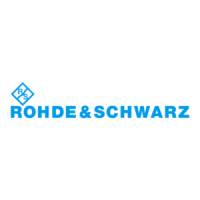Concepts and features
R&S
®
ZNA
283User Manual 1178.6462.02 ─ 20
Ref. receiver
Meas. receiver
10 dB
Port 2
Source
R&S®ZNAxx-B32:
R&S®ZNAxx-B22:
Ref Out
Ref In
Meas Out
Meas In
Source Out
Source In
Source step att
(0-70 dB/10 dB)
Receiver step att
(0-35 dB/5 dB)
R&S®ZNAxx-B302:
Low Noise Amplifier
(20-30 dB / 5 dB)
REF SOURCE MEAS
OUT
IN
OUT
IN
Port 2
Figure 4-40: LNA circuitry: direct access with reversed coupler configuration
This configuration changes the connection of the source and the receiver at the cou-
pler, as can be clearly seen in the simplified schematic in Figure 4-41. The LNA and
the cascaded receiver are therefore directly connected to the port without coupling
loss, which further improves the overall receiver noise figure.
Ref. receiver
Meas. receiver
Port 2
Source
R&S®ZNAxx-B32:
R&S®ZNAxx-B22:
Source step att
(0-70 dB / 10 dB)
Receiver step att
(0-35 dB / 5 dB)
R&S®ZNAxx-B302:
Low Noise Amplifier
(20-30 dB / 5 dB)
10 dB
Figure 4-41: LNA circuitry: reversed coupler configuration (simplified)
Reversing the coupler and activating the LNA at port 2 lowers the 0.1
dB compression
point to approximately ‑40 dBm. Choosing a lower gain of the LNA improves the com-
pression point.
4.7.36 Internal low power spur reduction amplifier
Hardware option R&S ZNA26-B501 | R&S ZNA43-B501
The purpose of option R&S ZNAxx-B501 is to lower the local oscillator (LO) leakage at
port 1, which is required for properly measuring high gain DUTs (> 60 dB) or DUTs with
low input compression.
To suppress the LO leakage, option R&S ZNAxx-B501 adds a switchable low noise
amplifier (LNA) to the receiving path of port 1. The LNA is located after the receiver
Optional extensions and accessories

